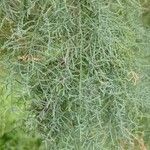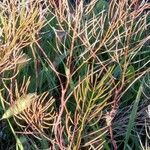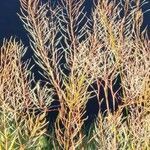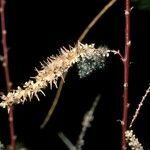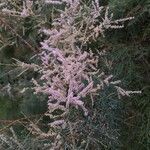Large shrub or tree to c. 10 m high, glabrous; branches tending to droop. Lvs 0.75-2.5-(4) mm long, lanceolate with broad sheathing base, almost subulate on strong vegetative shoots, entire, not markedly imbricate. Infl. a large, broad, terminal panicle composed of numerous spike-like racemes 2-5 cm long, appearing well after the lvs and on the current season's growth. Bracts 1-1.5-(2) mm long, narrow-lanceolate and acuminate to linear-subulate, pinkish, mostly > pedicels; fls 5-merous. Sepals 0.5-0.8-(1.2) mm long, ovate, green with hyaline, almost entire margin. Petals 1.3-2.2 mm long, broad-elliptic, pink; apex rounded or emarginate. Stamens 5, > petals; anthers pink. Disc of 5 rounded dark red lobes. Style red, stout, < or = petals; stigma stout. Capsule c. 8 mm long, narrowly pyramidal. Seed c. 0.5 mm long, cylindric; hairs united to form column in lower part, the free upper parts reflexed.
Tree 1.5-5.0 m high; bark brown to black, glabrous. Leaves sessile, base narrow, 1.5-3.0 mm long. Inflorescence 20-60 mm long racemes, initially pyramidal, later loose. Bracts ± equaling pedicels in length, upper ones narrowly triangular, acuminate, herbaceous. Flowers bisexual, pentamerous. Sepals trullate-ovate, subentire. Petals persistent, ovate-elliptic, pink. Disc fleshy, dark-coloured, margins 5-lobed. Stamens 5, antisepalous, inserted beneath disc, alternating with lobes (disc hololophic). Flowering time Mar.-Nov.
Shrubs or trees, to 8 m. Leaves: blade lanceolate to ovate-lanceolate, 1.5–3 mm. Inflorescences 2–6 cm × 5–7 mm; bract reaching or exceeding pedicel, not exceeding calyx tip. Flowers 5-merous; sepals 0.5–1.5 mm, margins entire; petals elliptic to ovate, 1.5–2 mm; antisepalous stamens 5, filaments alternate with nectar disc lobes, some or all originating from below disc. 2n = 24.
Evergreen tree, up to 5 m high. Bark black or dark brown; branches feathery. Leaves minute, scale-like. Flowers: in racemes at ends of long, thin twigs; sepals entire; petals ovate, pale to purplish pink; Sep.-Dec. Fruit papery, 3-4 mm long.
Has 5-merous fls, with the filaments arising from (or just outside) the sinuses of the 5-lobed disk (the disk lobes often emarginate). (T. ramosissima; T. pentandra, an illegitimate name)
